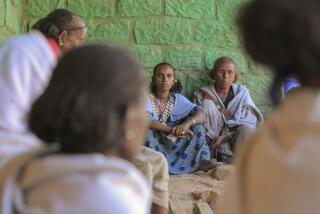Famine in Ethiopia
- Share via
Robert Seiple of World Vision wrote movingly abut the current famine in Ethiopia (Op-Ed Page, Feb. 17). His prescription for long-term development projects which would mitigate the effects of the next drought are basically on target: a market-oriented approach towards agricultural production, an “early-warning system” for potentially disastrous drought conditions, improved response time for both government and international organization assistance, cooperation from all sides of Ethiopia’s several civil conflicts regarding safe passage for relief trucks bound for feeding centers.
What I have to take exception to, however, is Seiple’s endorsement of U.S.A. for Africa’s method of funding long-term development projects out of the “We Are the World” proceeds. The criticism of U.S.A. for Africa has never been for intelligently realizing that long-term solutions to Africa’s water, health care and agricultural crises are necessary if Africa is to fully develop. Rather, it is for taking so long to initiate funding for these three-to-five year projects. There was no reason to wait until its emergency projects for health care, housing and transport assistance were fully funded for U.S.A. for Africa to then begin to fund longer-term projects.
Nearly two years passed before serious amounts of funds were expended to start up these much-needed and generally well thought-out projects. Both Catholic Relief Services and U.S.A. for Africa raised over $50 million on the premise that Africans were starving and in need of immediate assistance. That “immediacy” can fairly be thought to include the provision of seeds, farm implements, trucks and health centers but these must be funded quickly if they are to have any impact.
RICHARD M. WALDEN
President
Operation California Inc.
Los Angeles
More to Read
Sign up for Essential California
The most important California stories and recommendations in your inbox every morning.
You may occasionally receive promotional content from the Los Angeles Times.













